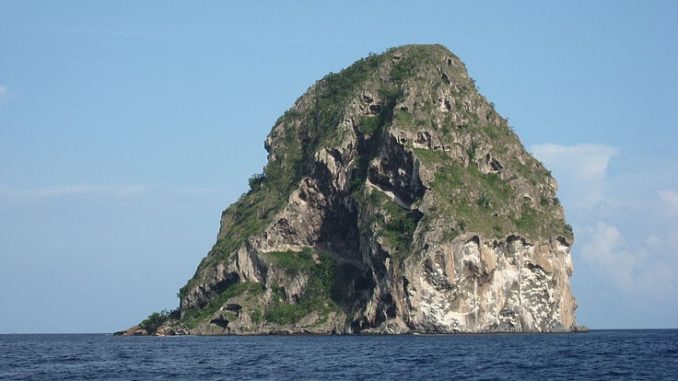
In 1803, the English were once again at war with the French. In the West Indies, the island of Martinique was a French région d’outre-mer (overseas region) of strategic importance the British wished to hobble, particularly the harbors of Fort Royal (aka, Fort-de-France) and Saint Pierre.
Commodore Samuel Hood (not to be confused with the famous Vice-Admiral Sir Samuel Hood, his first cousin) was assigned the task of blockading the ports. Diamond Rock, a small but very tall (175 meters, 574 feet) uninhabited island off the southwest tip of Martinique was itself strategic. Hood recognized that it could be employed to aid his blockade mission, being as it was in the direct path between Martinique and Saint Lucia, another French island directly to the south.
Hood wrote to the Admiralty, informing them that he had seized the island and commissioned it as a sloop-of-war, which he christened, HMS Diamond Rock. He fortified the new ‘ship’ with several batteries of cannon and a crew of 120 men to harass French shipping.
And harass the French they did. HMS Diamond Rock was such a thorn in the side that the French made several attempts to capture her, not succeeding until 1805.

HMS Diamond Rock was the first stone frigate, but there have been many others since, not only in the United Kingdom, but also in Commonwealth countries – particularly Canada, Australia, and New Zealand.
There are a couple of straightforward reasons for this historic curiosity. Originally, the Royal Navy was forbidden from having any authority on land. To get around this, they commissioned islands as His or Her Majesty’s Ship. One of the more famous islands was HMS Ascension, now known simply as Ascension Island.
Secondly, in 1866 Parliament wrote the Naval Discipline Act, but the code only applied to officers and men of the Royal Navy who were assigned to a ship. Those who broke the rules could only be punished if the men were recorded in the books of a Royal Navy vessel. Discipline was essential, yet so were land bases. The need to create naval training bases, hospitals, and later naval air bases on land led to the commissioning of these land-based facilities as Royal Navy ‘ships’, with an HMS prefix.
It’s worth noting that HMS Diamond Rock was never officially decommissioned.
Question of the night: How do you feel about being on the water, love it or hate it?
